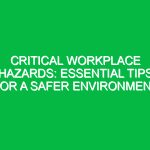Understanding Hazards in the Environment
Environmental Hazards encompass a wide range of factors that can negatively impact human health and Safety. Within the Health, Safety, and Environment (HSE) domain, understanding these hazards is crucial not only for compliance with Regulations but also for fostering a safe and sustainable environment. From air pollution to chemical spills, the threats posed by environmental hazards are diverse and often interconnected.
In this article, we will explore various environmental hazards, their implications for health and Safety, and actionable strategies to mitigate these risks. By understanding these hazards, individuals and organizations can take proactive steps to protect themselves and the communities they inhabit.
The Spectrum of Environmental Hazards
Environmental hazards can be categorized into several types, each with unique characteristics and Effects. Here, we delve into the most significant categories relevant to the HSE context:
1. Physical Hazards
Physical hazards include natural disasters such as earthquakes, floods, and hurricanes, as well as human-made risks like construction site accidents. These hazards can lead to severe injuries or fatalities if proper Safety Measures are not implemented. For instance, in 2010, the catastrophic earthquake in Haiti resulted in over 200,000 deaths and left millions homeless, highlighting the importance of disaster preparedness and response strategies.
2. Chemical Hazards
Chemical hazards arise from the release of harmful substances into the environment. This includes industrial chemicals, pesticides, and heavy metals. Exposure to these chemicals can lead to acute and chronic health issues, including respiratory problems, skin disorders, and even cancer. A notable example is the Bhopal gas tragedy in 1984, where a gas leak from a pesticide plant in India exposed thousands to toxic methyl isocyanate, resulting in thousands of deaths and long-term health complications for survivors.
3. Biological Hazards
Biological hazards include bacteria, viruses, and other pathogens that can cause illness. These hazards are particularly relevant in industries such as healthcare and agriculture. For instance, outbreaks of diseases like Ebola and Zika have underscored the need for stringent biosecurity measures. Ensuring proper sanitation and vaccination can significantly reduce the risk of biological hazards in workplaces and communities.
4. Ergonomic Hazards
While not always immediately apparent, ergonomic hazards can lead to long-term injuries and health issues, particularly in occupations involving repetitive movements or awkward postures. An example is the rise of musculoskeletal disorders among office workers due to poor workstation design. Implementing ergonomic assessments and adjustments can prevent these injuries and improve overall Workplace Safety.
5. Radiological Hazards
Radiological hazards involve exposure to ionizing radiation, which can occur in various settings, including nuclear power plants and medical facilities. Long-term exposure to radiation can lead to severe health issues, including cancer. The Fukushima Daiichi nuclear disaster in 2011 serves as a stark reminder of the potential dangers of radiological hazards, affecting not only workers but also nearby communities.
Health Impacts of Environmental Hazards
The health impacts of environmental hazards can be profound and far-reaching. Acute exposure can lead to immediate health crises, while chronic exposure may result in long-term health problems. Understanding these impacts is essential for developing effective mitigation strategies.
Short-term Effects
Short-term effects of environmental hazards can manifest as headaches, nausea, dizziness, and respiratory issues. For instance, during the 2016 Flint water crisis, residents suffered from lead poisoning due to contaminated drinking water, leading to a host of immediate health problems.
Long-term Effects
Chronic exposure to environmental hazards can result in serious health conditions, including cardiovascular diseases, neurological disorders, and cancers. For example, studies have shown a direct correlation between long-term air pollution exposure and increased rates of lung cancer in urban areas. Recognizing these long-term effects is critical for public health initiatives aimed at reducing environmental risks.
Mitigation Strategies for Environmental Hazards
To effectively protect health and safety in the face of environmental hazards, organizations and individuals must adopt comprehensive mitigation strategies. Here are key approaches to consider:
1. Risk Assessment
Conducting thorough risk assessments is the first step in identifying potential environmental hazards. This process involves evaluating the likelihood and impact of various hazards, allowing organizations to prioritize their Safety Measures. For example, a manufacturing facility might assess the risk of chemical spills and implement containment measures accordingly.
2. Training and Education
Providing Training and education about environmental hazards is essential for fostering a culture of safety. Employees should be educated on recognizing hazards, understanding safety protocols, and responding to emergencies. Regular drills and workshops can enhance preparedness and response capabilities.
3. Implementation of Safety Protocols
Establishing robust safety protocols can mitigate the risks associated with environmental hazards. This includes the use of Personal Protective Equipment (PPE), proper ventilation systems, and safe storage practices for hazardous materials. Organizations must ensure compliance with industry Standards and regulations to safeguard their workforce.
4. Emergency Preparedness Plans
Having a well-defined emergency preparedness plan is critical for responding to environmental hazards effectively. This plan should outline Evacuation Procedures, communication strategies, and resource allocation. Regular drills should be conducted to ensure that all personnel are familiar with the Procedures and can act swiftly in a crisis.
5. Community Engagement
Engaging with the community is vital for addressing environmental hazards effectively. Public awareness campaigns can educate citizens about local risks and available resources. Collaboration with local organizations can enhance community resilience against environmental challenges.
Regulations and Standards Governing Environmental Hazards
Compliance with environmental regulations is a critical aspect of managing hazards in the environment. Various local, national, and international regulations govern the management of hazardous materials, waste disposal, and pollution control.
1. Occupational Safety and Health Administration (OSHA)
In the United States, the Occupational Safety and Health Administration (osha) sets forth regulations to ensure Workplace Safety concerning environmental hazards. Employers are required to provide a safe working environment, implement safety protocols, and train employees on potential hazards.
2. Environmental Protection Agency (EPA)
The Environmental Protection Agency (EPA) plays a crucial role in regulating environmental hazards related to air and water quality, hazardous waste, and Chemical Safety. Compliance with EPA standards helps mitigate risks associated with pollution and protects public health.
3. International Standards
Global standards, such as those set by the International Organization for Standardization (ISO), provide guidelines for managing environmental hazards across industries. ISO 14001, for instance, focuses on effective environmental management systems, promoting Sustainability and risk reduction.
Conclusion
Understanding hazards in the environment is vital for safeguarding health and safety in our communities. From physical and chemical hazards to biological and ergonomic concerns, the spectrum of risks is vast. However, by implementing effective mitigation strategies and adhering to regulatory standards, we can significantly reduce the impact of these hazards.
The importance of addressing environmental hazards cannot be overstated; it not only protects individual health but also promotes environmental sustainability for future generations. As we move forward, let us remain vigilant and proactive in our efforts to mitigate environmental risks, ensuring a safer and healthier world for all.


